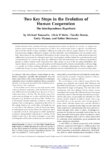1 - 25 of 9
| Creator | Title | Description | Subject | Date | ||
|---|---|---|---|---|---|---|
| 1 |
 |
Rogers, Alan R.; Jorde, Lynn B. | Genetic evidence on modern human origins | A review of genetic evidence leads to the following conclusions concerning human population history: (1) Between 33,000 and 150,000 years ago the human population expanded from an initial size of perhaps 10,000 breeding individuals, reaching a size of at least 300,000. (2) Although the initial popu... | Population history; Mitochondrial DNA; Mismatch distribution; Intermatch distribution; Replacement hypothesis; Population bottlenecks | 1995 |
| 2 |
 |
McCullough, John M. | Evidence for assortative mating and selection in surnames: a case from Yucatan, Mexico | Surnames are often used as metaphors for genetic material on the assumption of neutrality and general immunity from systematic pressures. The Yucatec Maya use surnames of both Maya and Spanish origin. We find evidence of positive assortative mating by ethnic origin of surname and a slight bias away ... | Surnames; Assortative mating; Maya | 1985 |
| 3 |
 |
Broughton, John | Homestead cave Ichthyofauna | Biological evidence on the climatic and hydrographic history of the intermountain region would be much richer, if we had more than the present dribble of paleontological data on the fishes (Hubbs and Miller, 1948, p. 25). In this passage from their landmark synthesis of historical fish biogeograph... | Homestead Cave; Ichthyofauna; Lake Bonneville | 2000 |
| 4 |
 |
Codding, Brian | Alternative aboriginal economies: Martu livelihoods in the 21st century | In the western deserts of Australia, hunting and gathering endures as an important social and economic activity. That foraging persists within the boundaries of developed industrialized nation states may come as a surprise to those who evaluate foraging as less profitable than agricultural, wage or ... | Aboriginal economics; Aboriginal foraging | 2015 |
| 5 |
 |
McElreath, Richard | Are peasants risk-averse decision makers? | For decades, researchers studying small-scale, subsistence-oriented farmers have sought to explain why these "peasants" seem slow to acquire new technologies, novel agricultural practices, and new ideas from the larger societies that have engulfed them. The early work on this question suggested that... | Subsistance farmers; Risk-aversion; Risk-taking; Cultural conservatism; Cost-benefit analysis | 2002 |
| 6 |
 |
Hawkes, Kristen | Stag hunts or rearing environments? | Tomasello et al. have made the case that shared intentionality distinguishes humans from our nearest living relatives. What accounts for the difference? The answer they offer is Stag Hunt choices faced by ancestral foragers. Noting problems with that answer, I urge attention to a promising alternati... | 2012-01-01 | |
| 7 |
 |
Rogers, Alan R. | Genetic variation at the MCIR Locus and the time since loss of human body hair | The melanocortin I receptor (MCIR) locus makes a protein that affects the color of skin and hair. At this locus, amino-acid differences are entirely absent among African humans, abundant among non-Africans (especially Europeans), and abundant in chimpanzee/human comparisons (Rana et al. 1999, Hardin... | Nonsynonymous; Chimpanzee; Constraint | 2004 |
| 8 |
 |
Hawkes, Kristen | Some current ideas about the evolution of the human life history | Human life history is characterised by a long juvenile period (weaning to reproductive maturity), and a long post-reproductive lifespan in females. How do we explain the differences between our nearest relatives, the great apes, and ourselves? This chapter summarises some recent attempts to use l... | Human life history; Fertility; Apes; Juvenile period | 1999 |
| 9 |
 |
Hawkes, Kristen | Alyawara plant use and optimal foraging theory | Various authors have remarked on the importance of seeds in the pre-European diet of central Australian Aborigines. The Alyawara, an Arandic-speaking group, were typical in this respect. They collected edible seeds from nearly half the eighty-five plant species in their traditional subsistence inven... | Australia; Aborigines; Foraging; Seeds | 1981 |
1 - 25 of 9
